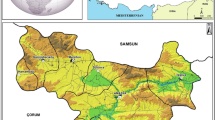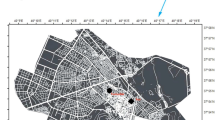Abstract
The interconnection between weather and climate and the performance, well-being, and human health cannot be overemphasized. The relationship between them is of both local and global significance. Information about weather, climate, and thermal environment is very important to human health and medical practitioners. The most crucial environmental information needed by medical practitioners and for maintaining human health, performance, and well-being are thermal conditions. The study used meteorological variables: air temperature, relative humidity, wind speed, solar radiation, and RayMan model as an analytical tool to compute physiologically equivalent temperature (PET) in order to assess thermo-physiological thresholds in Ondo State. The study revealed that there are marked spatial and seasonal variations in the environmental thermal conditions in the study area. The results of physiologically equivalent temperature for different grades of thermal sensation and physiological stress on human beings indicate that about 60 % of the total study period (1998–2008) fall under physiological stress level of moderate heat stress (PET 31–36 °C). In derived savannah, 32.6 % out of the total study period was under strong heat stress. In view of this, the study concluded that Ondo State may likely be prone to heat-related ailments and that some of the death recorded in the State, in recent times, may be heat-related mortality, but this is difficult to ascertain because there is no postmortem records in Nigeria where it could be confirmed. This type of study is relevant to help government to improve health care interventions and achieve Millennium Development Goals in health sector.







Similar content being viewed by others
References
Adebayo AA (2001) Temperature variability and outbreak of meningitis and measles in Yola, Nigeria. Global J Pure Appl Sci 1:133–136
Adefolalu DO (1995) Agro-climatological and ecological zones study of Ondo State, Nigeria. Final report, phase III, vol 2. Prepared by Federal University of Technology, Minna, Niger State, Nigeria
Adefolalu DO (1997) Hydro-ecozone mapping of Ondo/Ekiti State, Nigeria. Ondo State project, final report, p 141
Blazejczyk K, Epstein Y, Jendritzky G, Staiger H, Tinz B (2011) Comparison of UTCI to selected thermal indices. Int J Biometeorol 56(3):515–535. doi:10.1007/s00484-011-0453-2
Chase TN, Wolter K, Pielke RA Sr, Rasool I (2006) Was the 2003 European summer heat wave unusual in global context? Geophys Res Lett 33:L23709. doi:10.1029/2006GL027470
Driscoll DM (1992) Thermal comfort indexes. Current uses and abuses. Nat Weather Digest 17:33–38
Fanger PO (1970) Thermal comfort, analysis and application in environmental engineering. Danish Technical Press, Copenhagen, Denmark
Henson R (2008) The rough guide to climate change. Rough Guides Ltd, London
Höppe P (1993) Heat balance modeling. Experientia 49:741–745
Höppe P (1999) The physiologically equivalent temperature—a universal index for the biometeorological assessment of the thermal environment. Int J Biometeorol 43:71–75
IPCC (2001) Climate change 2001: impacts, adaptations and vulnerability. Contribution of working group II to the third assessment report of the intergovernmental panel on climate change. Cambridge University Press, New York
IRI (2011) Technical report on the climate information for public health training course, May 16–27, 2011. International Research Institute for Climate and Society, the Earth Institute at Columbia University Palisades, New York
Jendritzky G, Tinz B (2009) The thermal environment of the human being on the global scale. Glob Health Action 2:1–18
Kovats SR, Jendritzky G (2006) Heat-waves and human health. In: Menne B, Ebi KL (eds) Climate change and adaptation strategies for human health. Steinkopff, Darmstadt, Germany, pp 63–97
Landsberg HE (1972) The assessment of human bioclimate, limited review of physical parameters. World Meteorological Organisation, Technical Note No. 123, WMO-No. 331
Matzarakis A (2007) Climate, human comfort and tourism. In: Amelung B, Blazejczyk K, Matzarakis A (eds) Climate change and tourism: assessment of coping strategies. Maastricht–Warsaw–Freiburg, pp 139–154
Matzarakis A (2008) Relevance of thermal bioclimate for tourism in Japan. Glob Environ Res 12(2):129–136
Matzarakis A, Mayer H (1996) Another kind of environmental stress: thermal stress. Newsletters No. 18, WHO Collaborating Centre for Air Quality Management and Air pollution Control, 7–10
Matzarakis A, Mayer H, Iziomon M (1999) Application of a universal thermal index: physiologically equivalent temperature. Int J Biometeorol 43:76–84
Matzarakis A, Rutz F, Mayer H (2000) Estimation and calculation of the mean radiant temperature within urban structures. In: de Dear RJ, Kalma JD, Oke TR, Auliciems A (eds) Biometeorology and urban climatology at the turn of the millennium. Selected Papers from the conference ICB-ICUC 1999, WCASP-50, WMO/TD No. 1026, Sydney 2000, 273–278
Matzarakis A, Rutz F, Mayer H (2007) Modelling radiation fluxes in easy and complex environments—application of the RayMan model. Int J Biometeorol 51:323–334
Mayer H (1993) Urban bioclimatology. Experientia 49:957–963
Mayer H, Höppe P (1987) Thermal comfort of man in different urban environments. Theor Appl Climatol 38:43–49
McArthur K, Dawson J, Walters M (2010) What is it with the weather and stroke? Exp Rev Neurother 10:243–249
McClung G (2006) “What causes heat waves, and why are they dangerous?” Home Weather Stations Guide. 10 December, 2006
Meehl GA, Tebaldi C (2004) More intense, more frequent, and longer lasting heat waves in the 21st Century. Science 305(5686):994
NOAA (1995) The July 1995 heat wave natural disaster survey report, U.S. Department of Commerce, National Oceanic and Atmospheric Administration. National Weather Service, Silver Spring, MD, December
NPC (2006) Nigeria population census report. National Population Commission, Abuja, Nigeria
Omonijo AG, Matzarakis A (2011) Climate and bioclimate analysis of Ondo State, Nigeria, Meteorol Z. doi:10.1127/0941-2948/2011/0268
Parsons KC (2003) Human thermal environments: the effects of hot, moderate and cold environments on human health, comfort and performance. Taylor and Francis, London and New York
Robinson PJ (2001) On the definition of a heat wave. J Appl Meteorol 40(4):762–775
Shiue I, Matzarakis A (2011) When stroke epidemiology meets weather and climate: a heat exposure index from human biometeorology. Int J Stroke 6:176–178
Spagnolo J, de Dear R (2003) A field study of thermal comfort in outdoor and semi-outdoor environments in subtropical Sydney Australia. Build Environ 38:721–738
Spickett JT, Brown HL, Rumchev K (2011) Climate change and air quality: the potential impact on health. Asia Pac J Public Health 23(2):37S–45S
Stewart ID, Oke TR (2010) Thermal differentiation of local climate zones using temperature observations from urban and rural field sites. In: Preprints, 9th Symposium, on Urban Environment, Keystone, CO, 2–6 August 2010
Thomson Reuters (2009) Nigeria meningitis death toll rises above 2,000. Available on at http://in.reuters.com/article/
Tinz B, Jendritzky G (2003) Europa- und Weltkarten der gefuhlten Temperatur. In: Chmielewski F-M, Foken Th (eds) Beitrage zur klima- und Meersforschung, Berlin und Bayreuth, 111–123
UNICEF (2009) Report on meningitis in West and Central Africa
VDI (1998) Methods for the human-biometeorological assessment of climate and air hygiene for urban and regional planning. Part I: climate. VDI Guideline 3787. Beuth, Berlin
Yaka P, Sultan B, Broutin H, Janicot S, Philippon S, Fourquet N (2008) Relationships between climate and year-to-year variability in meningitis outbreaks: a case study in Burkina Faso and Niger. Int J Health Geogr 7:34. doi:10.1186/1476-072X-7-34
Acknowledgments
This research was partially funded by the African Doctoral Dissertation Research Fellowship offered by the African Population and Health Research Center (APHRC) in partnership with the International Development Research Centre (IDRC). The meteorological data were provided by the Agroclimatological and Ecological Monitoring Unit, Akure, Ondo State, and Nigerian Meteorological Agency, Lagos, Nigeria. We also thank the Alexander von Humboldt Foundation, Germany, for the award of International Climate Protection Fellowship to the lead author of this paper.
Author information
Authors and Affiliations
Corresponding author
Rights and permissions
About this article
Cite this article
Omonijo, A.G., Adeofun, C.O., Oguntoke, O. et al. Relevance of thermal environment to human health: a case study of Ondo State, Nigeria. Theor Appl Climatol 113, 205–212 (2013). https://doi.org/10.1007/s00704-012-0777-9
Received:
Accepted:
Published:
Issue Date:
DOI: https://doi.org/10.1007/s00704-012-0777-9




